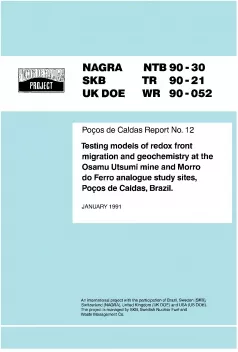
Technical Report NTB 90-30
Poços de Caldas Report No. 12Testing models of redox front migration and geochemistry at the Osamu Utsumi mine and Morro do Ferro analogue study sites, Poços de Caldas, Brazil
Redox fronts occur at a number of locations in repository systems and models have been established to describe their chemical evolution and spatial development. Such models can be tested against detailed observations of the well-developed redox fronts at the Osamu Utsumi mine.
Simple scoping calculations can explain the formation of redox fronts in very general terms but greatly simplify the processes known to be occurring at such fronts. Coupled transport / chemistry models can provide a better simulation of the fronts, but these are primarily interpretative models which have not yet displayed any convincing predictive abilities. They tend to be rather poor, in particular, in simulating trace element chemistry in either solution or solid phases.
Interpretative modelling of microbial activity, natural series profiles and trace element distributions gives strong indications of the reasons for the limitations of the chemical modelling. The role of microbial catalysis seems to be very significant in such systems, particularly affecting the redox chemistry of sulphur. Natural series measurements indicate very slow redox front movement at particular sites which could be due to precipitation processes limiting accessible porosity, a point not considered in any of the models. Finally, the trace element distributions strongly suggest immobilisation of many elements as co-precipitates or solid solutions in secondary iron minerals, again a process not considered by current models.
